Content
Putinka cherry is a useful and beautiful tree in a summer cottage that, with good care, brings abundant and tasty harvests. It is not difficult to grow cherries of this variety, it is enough to familiarize yourself with the basic rules of care.
Description of Putinka cherry
Putinka cherry is a hybrid of Antratsitovaya and Excellent Venyaminova varieties and is considered a young variety, it was bred in 2013. As you can see from the photo of the Putinka cherry variety and from the description of the variety, the tree belongs to the category of medium-sized, grows at an average pace, the crown of the cherry is moderately dense. Putinka is a "weeping" tree with drooping branches, shoots are covered with brownish-brown bark and have an arched shape.
Cherry leaves are rounded with a smooth sharpening at the tips, flat and curved downward, light green in color. The surface of the leaves is smooth and matte, covered with visible wrinkles. The tree blooms with small white-pink flowers, collected in umbrella inflorescences.

Putinka is a young cherry variety bred in 2013
Putinka cherry is included in the State Register for the Central Black Earth Region. It is recommended to grow it in a zone of temperate climate, the tree tolerates frosts in the middle zone well, but in the northern regions it can die over the winter.
Height and dimensions of an adult tree
The maximum height of Putinka cherry is 3 m. The crown of a tree of medium density and drooping shape, the shoots are arched and glabrous. The crown in diameter usually reaches 1-1.5 m.

A characteristic feature of the tree is the weeping shape of the shoots
Description of fruits
Putinka belongs to large-fruited varieties with one-dimensional berries. In appearance, the berries are wide-rounded, covered with a smooth and medium-hard skin of a dark red, almost burgundy color. The average fruit weight is 5.5 g, but some cherries can ripen up to 7 g.
Putinka's pulp is characterized by increased juiciness and light, unobtrusive sourness, mostly sweet cherries. A small bone separates well from the pulp. The tasting score of the fruit is 4.6.
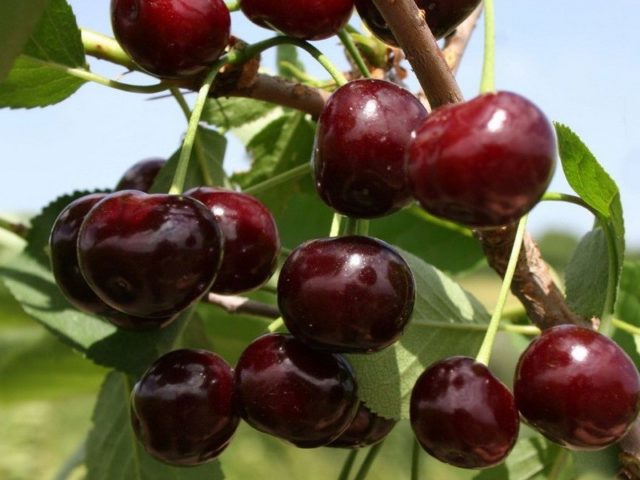
The taste of Putinki fruit is sweet, dessert
Putinka belongs to the sun-loving varieties, and its fruits are rarely baked in the sun. When ripe, the berries stay on the branches for a long time, so they can be picked gradually, without fear of rapid fall.
Cherry pollinators Putinka
Flowering of the variety begins in May and lasts 7-14 days; on cloudy days, Putinka blooms longer. According to the description of the Putinka cherry variety, pollinators are optional for it. It belongs to partially self-fertile plants, that is, it can bear fruit without pollinators, however, in this case, only 5-19% of the fruits will form.
To obtain a bountiful harvest near Putinka, it is recommended to plant pollinators - related varieties of cherries with similar flowering times. The varieties Zhukovskaya, Bystrinka, Kharitonovskaya are well suited as pollinators.
It should be noted that sweet cherries are also allowed for pollination.This is practiced quite often, for example, for the Putinka variety, the Iput cherry is well suited.

A tree can bear fruit without pollinators, but the harvest will be small
Main characteristics
Before planting Putinka on your site, you need to study its main characteristics. This will allow you to understand how careful maintenance the tree requires, and whether it brings rich yields.
Drought resistance, frost resistance
The variety tolerates short-term dry periods quite well. However, prolonged drying of the soil is harmful for Putinka - this negatively affects the yield. Therefore, when growing a tree, you need to ensure that it receives enough moisture during flowering and during fruiting.
Putinka has a high frost resistance - the variety is suitable for growing in regions where winter temperatures drop to -35 ° C. During severe cold weather, no more than 25% of all flower buds die. However, gardeners need to take into account that Putinka feels most comfortable in a temperate climate, where it can bring maximum yields.
Yield
Fruits on cherries of this variety ripen rather late, in late July and early August. Putinka begins to bear fruit in the fourth year after planting, while her yield is quite high - from 8 to 12 tons of juicy berries per hectare. The abundance of the crop depends on the growing conditions of the fruit tree. Most of the fruits are cherry, which grows in a sunny area in a region with warm winters, and the flower buds of the tree do not die during frosts.
Putinka belongs to universal varieties, so the fruits are suitable for any purpose:
- for preparation and drying;
- for preservation and preparation of jams and preserves;
- for juices;
- as a filling for baking;
- for making homemade alcoholic beverages;
- to add to meat dishes;
- for making marshmallows or candied fruits.
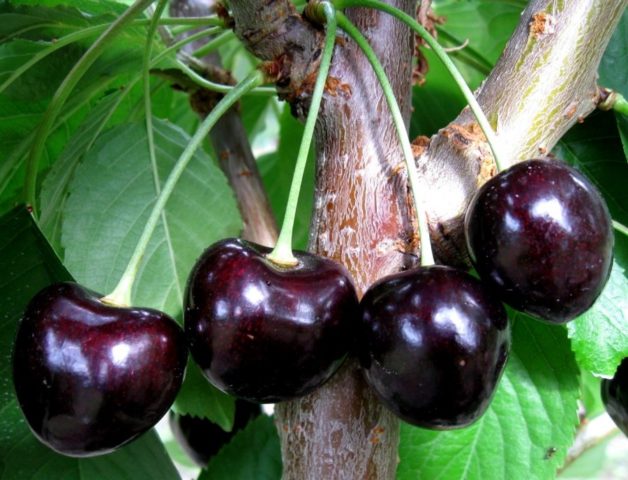
Putinka fruits are versatile and suitable for any processing
Putinka is stored well enough, so it can be transported and sent for sale. True, in this case, it is recommended to remove the berries from the branches a couple of days before ripeness, so that they finally ripen on the way.
Advantages and disadvantages
Having carefully studied the characteristics of the Putinka cherry variety, the following advantages can be distinguished:
- high productivity;
- partial self-fertility;
- large size and dessert taste of the fruit.
Separately, it should be noted that Putinka is one of the few cherry varieties that are resistant to coccomycosis and monilial burn at the same time. These diseases are very dangerous for cherries, so Putinka's good immunity is an additional important advantage.
The disadvantages of the variety include average frost resistance. In cold regions, cherries still bear fruit, but you can not expect the maximum yield from them, some of the flower buds die during cold weather.
Landing rules
Planting Putinka on your site is very simple. You need to adhere to the correct timing and algorithms for the tree to take root well.
Recommended timing
It is best to plant Putinka in open ground in the spring - in mid-April. In summer and autumn, planting is also possible, but it is better to do this in the southern regions. In temperate climates and northern regions, cherries may not have time to get stronger by winter and will die.
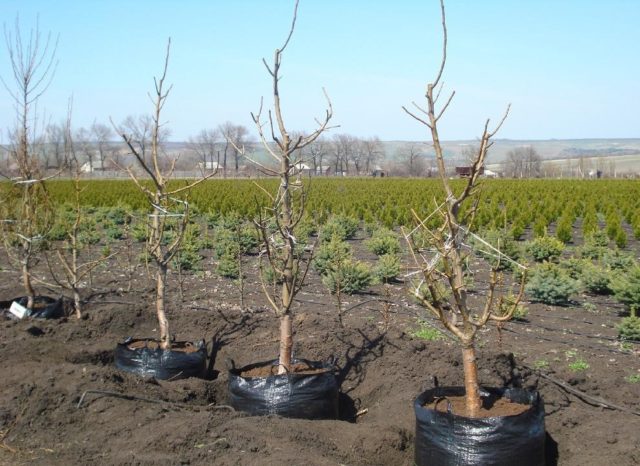
Planting a tree is best in spring, so that it has time to get stronger.
Site selection and soil preparation
Putinka prefers well-lit, sunny locations. The soil for the tree must be selected fertile, without stagnant moisture.
Before planting a seedling, it is necessary to prepare the soil. In the selected area, a hole is dug about 50 cm deep and about 60 cm in diameter, after which 1 kg of superphosphate, 2 buckets of rotted humus and 1 glass of slaked lime are laid on the bottom in layers.
How to plant correctly
The Putinki landing algorithm practically does not differ from the standard scheme:
- The planting hole is filled with soil and fertilizers up to half.
- The seedling, previously soaked in water for a couple of hours, is carefully lowered into the pit, making sure that its roots are not tangled or broken.
- The hole is covered with soil to the brim, and then the trunk circle is mulched.
Care features
Putinka is rather unassuming in terms of growing conditions. However, the basic rules of care must be followed for her in order to get a good harvest.
Watering and feeding schedule
Cherry tolerates short droughts well, but does not relate well to stagnant moisture. Therefore, the plant is watered moderately, only in the hot summer months it is necessary to pour 10-15 liters of warm water weekly along the diameter of the trunk circle. Water the cherries in the evening so that the water does not evaporate longer.
It is also necessary to pay attention to watering during flowering and the formation of ovaries, when the cherry especially needs moisture and nutrients. If the summer is hot, then you need to water the cherries during the ripening of the berries, but no later than half a month before harvesting, otherwise the fruits may crack.
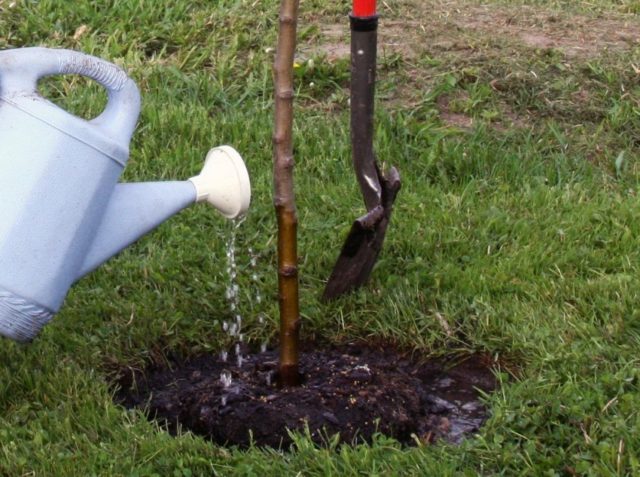
The plant is watered moderately - Putinka does not like a long drought, but does not tolerate waterlogging either
Putinka cherries are fed mainly in the fall, shortly before the onset of cold weather. You can scatter compost, bird droppings and manure around the trunk, and mixed mineral-organic fertilizers - sodium humate, humofos, peat-ammonia mixtures - will also benefit the tree. In the spring, you can feed the cherry with nitrogen, this will contribute to the growth of green mass and good flowering.
Pruning
An overly dense crown can damage yields, since the branches located in the depths, in this case, will not receive enough sunlight. When growing cherries, it is recommended to thin out, cut branches longer than 40 cm.
Also, annually you need to assess the condition of the plant and carry out sanitary pruning - remove diseased and broken shoots. It is necessary to prune in the fall, during this period the cherry goes to rest, and the procedure is less traumatic for it.
Preparing for winter
Although cherry tolerates moderate frosts well, it is still better to cover it for the winter, especially if the tree is young. Preparation for winter is that the trunk circle is mulched abundantly - this allows you to protect the soil and roots from freezing.
The trunk of the cherry is covered with spruce branches. You can also wrap the trunk with non-woven fabric or light burlap, which will additionally protect the tree from rodents.
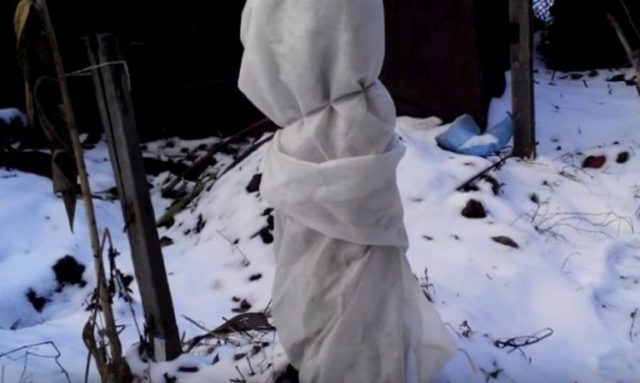
For the winter, it is better to cover the trunk with a special material.
Diseases and pests
One of the main advantages of the variety is that Putinka cherry rarely suffers from fungal ailments. The greatest danger for her, as for any cherries, is coccomycosis and moniliosis, which lead to the death of the tree, but in practice Putinka is almost not affected by them.
Of the pests, cherries can be threatened by weevils, sawflies and aphids. They also rarely appear on cherries, most often - with a massive pest infestation of neighboring trees.
Conclusion
Putinka cherry is a tasty and easy-to-grow variety with important advantages. The plant tolerates a temperate climate well, does not require particularly careful care and is almost not affected by fungi and pests. The Putinka harvest is delicious and plentiful.
Reviews of the Putinka cherry variety








